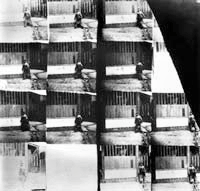| |||
|---|---|---|---|
| +... | |||
| Years in film |
|---|
 |
| 19th century |
| 1870s |

The year 1887 in film involved some significant events.
| |||
|---|---|---|---|
| +... | |||
| Years in film |
|---|
 |
| 19th century |
| 1870s |

The year 1887 in film involved some significant events.
| Month | Date | Name | Country | Profession | Died | |
| January | 11 | Monte Blue | US | Actor | 1963 | |
| 13 | Gabriel Gabrio | France | Actor | 1946 | ||
| 13 | Sophie Tucker | France | Actress, Singer | 1966 | ||
| 21 | André Andrejew | Russia | Set Designer | 1967 | ||
| February | 16 | Kathleen Clifford | US | Actress | 1962 | |
| 26 | William Frawley | US | Actor | 1966 | ||
| March | 18 | Frank Moran | US | Boxer, Actor | 1967 | |
| 21 | Frank Urson | US | Director, Cinematographer | 1928 | ||
| 24 | Roscoe Arbuckle | US | Actor, Comedian | 1933 | ||
| April | 9 | Konrad Tom | Poland | Actor, screenwriter, director | 1957 | |
| 12 | Harold Lockwood | US | Actor | 1918 | ||
| 23 | Jenő Törzs | Hungary | Actor | 1946 | ||
| May | 1 | Kurt Vespermann | Germany | Actor | 1957 | |
| 18 | Jeanie MacPherson | US | Actress, screenwriter | 1946 | ||
| 21 | Mabel Taliaferro | US | Actress | 1979 | ||
| 30 | Paulette Noizeux | France | Actress | 1971 | ||
| June | 1 | Clive Brook | UK | Actor | 1974 | |
| 16 | Aage Bendixen | Denmark | Actor | 1973 | ||
| July | 17 | Jack Conway | US | Director, producer | 1952 | |
| August | 1 | Anthony Coldeway | US | Screenwriter | 1963 | |
| 5 | Reginald Owen | UK | Actor | 1972 | ||
| 10 | Sam Warner | US | Film Mogul | 1927 | ||
| 14 | Marija Leiko | Latvia | Actress | 1937 | ||
| September | 5 | Irene Fenwick | US | Actress | 1936 | |
| 9 | Raymond Walburn | US | Actor | 1969 | ||
| 26 | Antonio Moreno | Spain | Actor | 1967 | ||
| 30 | Lil Dagover | Germany | Actress | 1980 | ||
| October | 5 | Manny Ziener | Germany | Actress | 1972 | |
| 7 | Jack Mulhall | US | Actor | 1979 | ||
| November | 9 | Gertrude Astor | US | Actress | 1977 | |
| 11 | Maurice Elvey | UK | Director, producer | 1967 | ||
| 11 | Roland Young | UK | Actor | 1953 | ||
| 23 | Boris Karloff | UK | Actor | 1969 | ||
| 30 | Gyula Szőreghy | Hungary | Actor | 1943 | ||
| December | 9 | Tim Moore | US | Actor | 1958 | |
| 23 | John Cromwell | US | Actor, producer, director | 1979 | ||
| 29 | Pierre Watkin | US | Actor | 1960 | ||